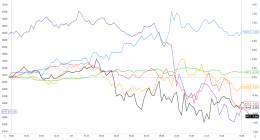
The broader labor-market recovery is continuing, but showed signs of slowing in November.
Photo: Spencer Platt/Getty Images
Worker applications for unemployment benefits rose sharply last week, an indication layoffs remain at a high level nearly nine months into the coronavirus pandemic.
Weekly initial claims for jobless benefits, a proxy for layoffs, rose by 137,000 to a seasonally adjusted 853,000 in the week ended Dec. 5, the Labor Department said Thursday. That marked the highest level of applications since September, but was still well down from a peak of nearly seven million in late March.
Jobless claims have mostly trended down since the spring, when the pandemic caused widespread business shutdowns. That matches with other measures showing the economy is recovering, but at a slower pace in recent months.
Jobless claims data has been viewed as a bellwether for economists and policy makers for a half-century. However, the Government Accountability Office, a federal watchdog, last month said jobless claims have contained inconsistent data because of the pandemic-related surge in applications and attempted fraud. The Labor Department said it doesn’t plan to change its methodology. Economists also caution the claims figures can be volatile from week to week, especially around holiday periods.
“Job destruction has not come to an end,” Andy Challenger, senior vice president at outplacement firm Challenger, Gray & Christmas Inc., said before Thursday’s data. “We might be gaining jobs overall, but thousands of people are losing their jobs every week because demand has not returned.”
The broader labor-market recovery is continuing, but showed signs of slowing in November. Employers added 245,000 jobs last month, the Labor Department said last week. While it was the seventh consecutive month of gains, hiring has cooled. At November’s rate of job growth, employment wouldn’t return to pre-pandemic levels until 2024.
Mr. Challenger said recent layoffs have occurred in the entertainment and leisure industry, including at restaurants, as well as at retailers and in the transportation sector, at employers including airlines and transit authorities. Many workers laid off this spring expected to return to their jobs fairly quickly. Those laid off in recent weeks are more likely to have seen their position eliminated, Mr. Challenger said.
“When someone is let go today, that means the company doesn’t see that job existing for a while,” he said.
The U.S. economy overall has recovered much of the ground lost earlier this year, but the expansion’s momentum has eased since the summer’s swift gains. Consumer spending rose in October for the sixth straight month, though at a slower pace, according to the Commerce Department. The manufacturing and services sectors expanded in November, according to the Institute for Supply Management.
There are ample job openings in several industries, including in the finance, accounting and technology sectors, said Paul McDonald, senior executive director at professional staffing firm Robert Half International Inc.
“We’re still seeing strong demand,” he said. “But those with jobs are reluctant to leave.” He said some fear they will lose seniority and be at greater risk for a layoff if the economy weakens. While total job loss this year was much higher than in the 2007-2009 recession, the finance sector has been less affected, and many firms are hiring, Mr. McDonald said, to keep up with demand for mortgage refinancing and home and auto loans.
Just more than 20 million workers were receiving unemployment benefits in mid-November, according to the Labor Department. That includes those paid through regular state programs, which provide unemployment insurance covering the vast majority of workers, and two pandemic programs created earlier this year.
Those programs—one for gig workers and others not typically eligible for jobless benefits, and another for those who have exhausted eligibility for other programs—are set to expire at the end of the year. People in the pandemic programs accounted for most of those receiving benefits last month.
Grace Keros last month laid off all but four staff members from American Coney Island, a downtown Detroit diner that employed more than 20 workers before the pandemic, after the state of Michigan imposed new restrictions on in-person dining. Ms. Keros, the owner, is now limited to carryout orders and closes the former 24-hour joint as early as 4 p.m.
“In March, I had to call the locksmith to help me lock up because I couldn’t find the key,” she said.
When spring restrictions were lifted, Ms. Keros said she was able to bring back about half her staff, but sales were down with fewer office workers in the area and no crowds from baseball games or events. Now with winter approaching, and unable to serve diners inside, she said she is worried about her future, and that of her employees, especially because they won’t receive an extra $600 a week in unemployment benefits. Those enhanced benefits ended in July and other federal programs are set to expire this month.
“If we’re going to be told we can’t operate, the government needs to get its act together and help these workers,” she said.
By submitting your response to this questionnaire, you consent to Dow Jones processing your special categories of personal information and are indicating that your answers may be investigated and published by The Wall Street Journal and you are willing to be contacted by a Journal reporter to discuss your answers further. In an article on this subject, the Journal will not attribute your answers to you by name unless a reporter contacts you and you provide that consent.
Write to Eric Morath at [email protected]
Copyright ©2020 Dow Jones & Company, Inc. All Rights Reserved. 87990cbe856818d5eddac44c7b1cdeb8







